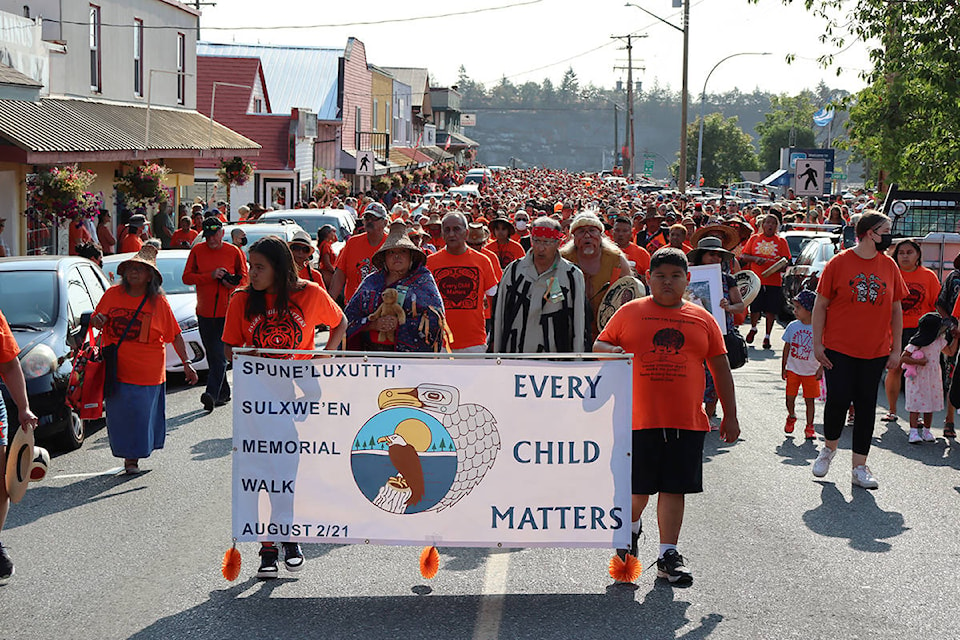More than 1,500 people from many walks of life gathered together for the Penelakut Tribe’s March for the Children in Chemainus Monday in a show of force for desired change and to call on governments to acknowledge the truths about Canada’s residential school system.
RELATED: More than 160 unmarked graves found near former residential school on Penelakut
“Today we are walking for the children who didn’t have the chance to walk with us today,” Penelakut chief Joan Brown said to attendees. “I’d like to thank you all for being here walking with the survivors — walking together as one. We’re all holding each other up at this time. This is a very emotional time for a lot of the survivors and the families of children who were lost. Today we honour them. They were not forgotten.”
Penelakut Island was previously known as Kuper Island where the Kuper Island Industrial School operated from 1889 until 1975. It was run by the Catholic Church until 1969 before being taken over by the federal government.
Last month, Penelakut disclosed to neighbouring First Nations that more than 160 unmarked graves were found on the grounds of the former residential school.
Mike sul-xwumqun Charlie is the chairman of the Penelakut Elders Treaty Committee. He said that the work to locate the unmarked graves has been ongoing since 2014. Initially, work was funded through the Truth and Reconciliation Comission. But when funding ran out, Andrew Martindale and Eric Simons from the UBC Department of Anthropology conducted the site investigation, including the use of ground-penetrating radar analysis, for free.
Penelakut was inspired to share their findings after Tk’emlúps te Secwepemc announced that they had found 215 unmarked graves at the former Kamloops Indian Residential School.
RELATED: More graves could be found at Kamloops residential school site, Tk’emlúps report indicates
“Our elders felt it was time to do something — time to speak for the ones who can’t speak,” Charlie said, “We’re letting the federal government and the Roman Catholic Church know that they have a financial responsibility for our young loved ones that never made it home.”
RELATED: ‘Who is going to be accountable?’: Action urged in Kuper Island residential school grave findings
Speaking to Black Press Media, Professor Andrew Martindale said it was important for him to do the work on a volunteer basis.
“The work needs to get done. I think this is a responsibility that non-Indigenous Canadians inherit and bear. I don’t think it’s appropriate to ask communities who are already stretched on so many fronts to commit resources to carry this work on. It’s a responsibility that the federal and provincial governments have — to provide resources for this kind of work,” he said.
Martindale called on the federal government and churches that ran residential schools across Canada to release any and all documents on residential schools so researchers and First Nations can find and search burial sites.
The March for the Children has been in the works since June and the Penelakut were blown away by the response.
“The committee cannot believe the turnout,” said Jonathan Joe, who emceed a program of speeches, dance and spiritual songs that followed the march in Waterwheel Park.
It’s easily the largest crowd to attend an event of any kind in Chemainus in many years.
They came from First Nations all over the Island, the Lower Mainland and beyond, with non-Indigenous persons adding their support in large numbers, many clad in trademark orange shirts.
The event attracted numerous Indigenous leaders and political dignitaries, and even a few celebrities like legendary Vancouver Whitecaps’ soccer player Carl Valentine.
“I really felt it was important for me to support this event because it’s an awareness and an education to what the First Nations people have gone through in their lives,” said Marion James of Chemainus, whose father attended the residential school in Port Alberni for nine years.
“This is a really good start to non-Natives to learn about what we’re all about. There’s always fear and mistrust. This is a really good start to breaking down barriers.”
The Penelakut Tribe received praise for its organization of the event, spreading its message far and wide, with so many people from neighbouring communities having attended the Kuper Island Industrial School.
Many made passionate speeches about the acknowledgements that need to be made about the residential school system and the path to take going forward by joining forces for a better world.
“We’ve held it in for a long time,” said Danny Henry of Cowichan Tribes and Penelakut descent. “We’re hurting and we want to feel better.
“I really hope all of you can look around and give a fist pump to the person beside you or behind you and say ‘thank you.’”
Former Cowichan Tribes Chief Lydia Hwitsum was recently named an Indigenous liaison along with Charlene Belleau to provide advice and expertise to First Nations and the provincial government.
“We all have a role to play,” she said. “We can all reach out our helping hand. reach out, learn the true history of our people.
“My heart aches, but I’m also full of love. That’s what my mother taught me and that’s how we’re going to make it.”
